WHY FOCUS ON MATTHEW’S DISCOURSE?
PMW 2025-029 by Kenneth L. Gentry, Jr.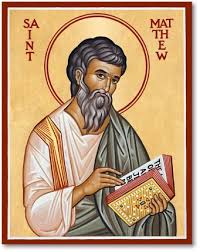
The “Olivet Discourse” is known by scholars as the “Eschatological Discourse.” This title focuses on its content, not its context; on what it teaches, not on where it was given. Though this fundamental Discourse appears in all three of the Synoptics (Matt. 24–25; Mark 13; Luke 21), in this posting I will explain why I focus on Matthew’s version of the Olivet Discourse in my research. I will present seven important reasons.
First, Matthew’s version is in the most Jewish Gospel
“It is agreed on all hands that this is a very “‘Jewish’ Gospel” (Leon Morris). This is significant in that the Discourse is sparked by deeply Jewish concerns raised by the Lord’s disciples (Matt. 24:1–3; cp. Mark 13:4). This includes highlighting the Jewish temple (“holy place,” v. 15; cp. vv. 1–2), its geographical setting in Judea (v. 16), and a distinctly Jewish Sabbath concern (v. 20). Robinson declares that “Matthew is more concerned than any other evangelist with the relationship of Christianity to the temple, the priesthood and the sacrifices” (J. A. T. Robinson).
Grant Osborne notes that “Matthew writes a Jewish gospel,” because he “especially had the Jewish Christian church and the Jewish people in mind.” John Nolland speaks of “the profound Jewishness of the whole of the Gospel of Matthew,” reminding us that it is “often and truly described as the most Jewish of the Gospels.” Darrell Bock writes that Matthew “is the one most focused on Jewish issues and concerns.” Robert Gundry speaks of “the profound Jewishness of the whole of the Gospel of Matthew.”
As I have argued elsewhere, Matthew presents a quite negative view of first-century Israel. And the Olivet Discourse forms the very climax to this negative angle in his teaching. Thus, the Discourse finds its fuller context in its setting in the whole Gospel. It should be helpful, therefore, to consider the Jewish nature of Matthew’s presentation of Olivet.
Olivet Discourse Made Easy (by Ken Gentry)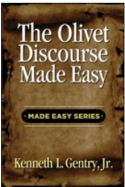
Verse-by-verse analysis of Christ’s teaching on Jerusalem’s destruction in Matt 24. Shows the great tribulation is past, having occurred in AD 70, and is distinct from the Second Advent at the end of history. Provides exegetical reasons for a transition from AD 70 to the Second Advent at Matthew 24:36.
See more study materials at: www.KennethGentry.com
Second, Matthew’s version is in the most influential Gospel
Though many scholars argue for Marcan Priority, the evidence from the early church Fathers strongly suggests Matthew was the first Gospel produced. [1] Because of this, Matthew was the most influential Gospel in the early church, being the one most cited by the Fathers. As ISBE2 (3:280) notes: “The Gospel of Matthew dominated the attention of the early Church, at least so far as the Synoptic Gospels are concerned, to the extent that it all but eclipsed the others.”
Matthew still remains the most influential of the three Synoptic Gospels even today. Osborne notes to this end: “Matthew has always been the gospel most widely read and the one first consulted for details about the life of Christ.” As one major Bible encyclopedia comments: “The Gospel according to Matthew has always occupied a position of highest esteem in the faith and life of the Christian church…. It may be that the early Christians placed it in first position in the NT canon precisely because of the profound influence of its contents” (ZEB 4:131).
Third, Matthew’s version appears climactically as Jesus’ final discourse
A well-known feature of Matthew is its highlighting five major discourses: the Sermon on the Mount (Matt. 5–7), the Missionary Discourse (Matt. 10), the Kingdom Parables (Matt. 13), the Community Life Discourse (Matt. 18), and finally the dramatic Olivet Discourse (Matt. 24–25). (Interestingly, of Jesus’ five major Discourses in Matthew, only the Sermon on the Mount [Matt. 5:1; 8:1] and the Olivet Discourse [Matt. 24:3] specify a mountainous location). As Osborne observes: “Matthew has structured his gospel very differently from the others and organized it around the five discourse units.” Each one of these ends with: “when he had finished these words” (Matt. 8:1; 11:1; 13:53; Matt. 19:1). But as Gibbs points out, Matthew inserts a “summarizing addition of ‘all’ to it transitional formula” at Matt. 26:1, which concludes the five discourses: “when Jesus had finished all these words.”
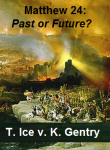
Matthew 24 Debate: Past or Future?
(DVD by Ken Gentry and Thomas Ice)
Two hour public debate between Ken Gentry and Thomas Ice on the Olivet Discourse.
See more study materials at: www.KennethGentry.com
As Christ’s last large-scale, formal instruction, it powerfully serves as the climax to his whole teaching ministry. Thus, it gives us insights into his ministry to Israel, which ministry was rejected by the nation as a whole (Matt. 23:37; 27:25). Olivet, therefore, serves as the Lord’s final warning to Israel.
However, Jesus is not merely a Jewish sage with a narrow, local, ethnic focus. The first part of the Discourse focuses on Jerusalem and the temple (Matt. 24:4–34). But this focus also provides a springboard for his warning of the Final Judgment of “all the nations” (Matt. 25:32), which is his concern in Matt. 24:37–25:46. I will provide a thorough exegetical argument for this in ch. 9.
Jeannine Brown well argues that “Jesus’ teachings turn from the signs portending the temple’s imminent destruction (24:4–35) to his reappearing (his parousia at the end of the age [see 24:3]), which will occur without warning (24:36–51).” This is significant in that as Jesus’ ministry unfolds to its end, Israel is turning more vehemently against him. This opens the door for the nations, which is the goal of the Gospel in its final verses containing the Great Commission (Matt. 28:18–20; contra Matt. 10:5–6; 15:24).
Fourth, Matthew’s version is the longest in the Synoptic Gospels
Matthew devotes two whole chapters of ninety-seven verses to Olivet. The second longest version is Mark’s, which is much shorter being contained within one chapter of only thirty-seven verses. The fuller record of the Lord’s instruction should be helpful to better understanding that teaching. Plus this gives us more material to analyze as we seek a better understanding of this important Discourse.
This also fits well with the observation that Matthew’s Gospel has a negative approach to first-century Israel. As Bock well notes: “For Matthew, Jesus’ relationship to Israel and explaining Israel’s rejection are major concerns.” Thus, Matthew’s longer Discourse denouncing Israel shows his great interest in Jesus’ judgment against her.
Understanding the Olivet Discourse 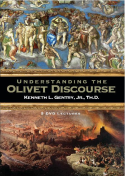
By Ken Gentry
This 5 DVD lecture set was filmed at a Bible Conference in Florida. It explains the entire Olivet Discourse in Matt. 24–25 from the (orthodox) preterist perspective. This lecture series begins by carefully analyzing Matt. 24:3, which establishes the two-part structure of the Discourse. It shows that the first section of the Discourse (Matt. 24:4–35) deals with the coming destruction of the temple and Jerusalem in AD 70. This important prophetic event is also theologically linked to the Final Judgment at the end of history, toward which AD 70 is a distant pointer.
For more educational materials: www. KennethGentry.com
Fifth, Matthew’s version has the fullest historical introduction
The Discourse appears just after Jesus’ calling down seven woes upon the scribes and Pharisees, which finally demonstrates the failure of Israel’s leadership and the doom that awaits them. In Matthew the woes consume an entire chapter of thirty-nine verses (Matt. 23:1–39). But in Mark the woes are summarized in only three verses (Mark 13:41–44).
Literary context is an essential aid to proper interpretation. In their highly-regarded work on interpretation, Walter Kaiser and Moises Silva urge: “Do emphasize the context. This is the fundamental principle. It is in fact the guideline that undergirds all of the others…. Before tackling a specific problem in one verse, we ought to read and reread the whole chapter — indeed, the whole book of which it is a part.”
Osborne provides a study of how to determine meaning in a text. He notes several errors of interpretation arising from focusing on smaller units of meaning: “Ignoring the Context. In one sense this is the basic error that encompasses the others and makes them possible…. The failure to note context may be the most frequently occurring error.” Robert Thomas notes that “traditional interpretation has consistently insisted on the importance of context in determining the meaning of a word or passage.”
Sixth, Matthew’s version has the fuller question of the disciples
Matthew’s record of their question contains sixteen words in the Greek (Matt. 24:3). And though Mark’s version has about the same number with fourteen words (Mark 13:4), Matthew’s version contains two distinct terms that cast more light on the matter: the Greek word parousia (“coming, presence”) and the Greek noun sunteleia (“completion, close, end”).
Seventh, Matthew’s version has the clearest literary structure
In Matthew 24:3 the disciples ask two questions. Due to their confusion, they believe their double question applies to the same, singular historical era. They do not realize the components of their double question refers to two historically-distinct eras.
Following J. M. Kik, R. T. France, J. A. Gibbs, David Garland, J. K. Brown, and others, the transition passage in Matt. 24: 34–36 provides powerful evidence that Jesus is shifting his attention from their first question to their second, from one topic to another. He is turning from the sign-filled (e.g., vv. 5–8, 25), near-term (Matt. 24:34) destruction of the temple (cf. Matt. 24:2) in AD 70 to the sign-less (Matt. 24:36, 39, 42, 44), historically-distant (Matt. 24:48; 25:5, 19) Final Judgment at the Last Day (cf. Matt. 25:31–46).
Jesus employs a significant transition marker to this end: he uses the prepositional phrase peri de (“now concerning”). In his Exegetical Guide to Matthew, Quarles points out that peri de with the gen[itive] … prob[ably] marks a major shift in topic in the discourse… De marks the next development in the discourse and the peri phrase announces the new topic.” Thus, as Gibbs notes, “the prepositional phrase at the beginning of 24:36. . . provides the hinge on which Jesus’ Eschatological Discourse turns from its first half (24:4–35) to its second (24:36–25:46).”
Notes
1. For a helpful defense of the priority of Matthew, see Robert L. Thomas and F. David Farnell, The Jesus Crisis: The Inroads of Historical Criticism into Evangelical Scholarship (Grand Rapids: Kregel, 1996). Gary W. Derickson, “Matthean Priority/ Authorship and Evangelicalism’s Boundary,” TMSJ (Spring 2003): 14:1: 87–103. See also Jeffrey A. Gibbs, Matthew 1:1–11:1 (St. Louis: Concordia, 2006), 64–66.
Click on the following images for more information on these studies:

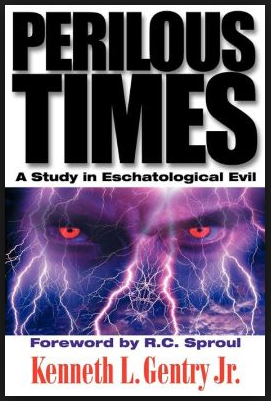
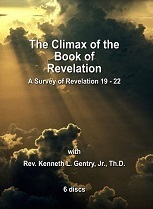
Kenneth L. Gentry Jr.'s Blog
- Kenneth L. Gentry Jr.'s profile
- 85 followers



